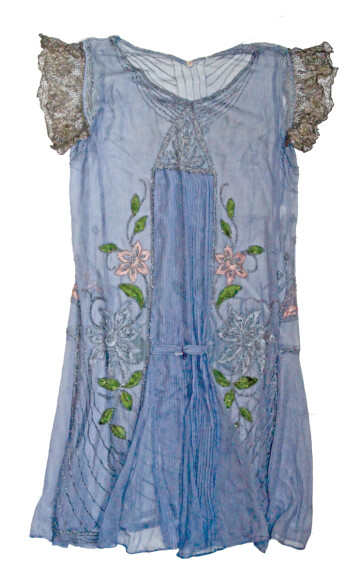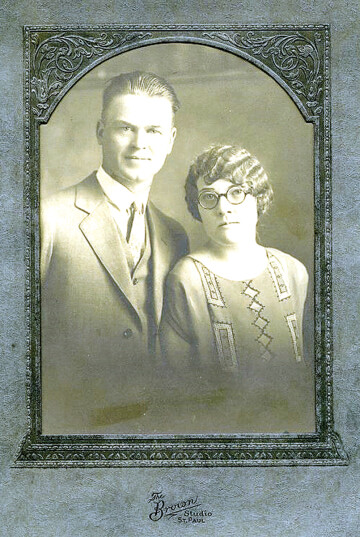More than 27 Dresses Wedding Attire from 1881-1992
Kelly Hartman | Sunday Apr. 1st, 2018
In a clothing collection that contains over 250 dresses, 16 percent, or about 40 pieces, are wedding attire. These outfits date from the late 1800s through the 1990s and show how fashion has changed over time. The wonderful thing about the Gallatin History Museum’s collection is that in most cases, we know who wore the dress and when; and in a few beautiful instances, we even have a photo in our archives of the bride in her gown. Those connections between the 3D textile itself to the 2D image captured in time are magical.
The oldest wedding outfit in the Museum’s collection dates to 1881 and consists of three pieces: a jacket or bodice, a skirt and a small bowler style hat. The material is a thick tan fabric, but is elegantly adorned with white lace, a patterned cream fabric, ruffles and a rope applique. The skirt is meticulously pleated and accented with ruffled trim. One could easily imagine this outfit worn for both the special occasion of marriage as well as other events requiring elegant dress, which was true for most women throughout history. Purchasing a dress for one day only was uncommon, particularly because each gown was made to order for her specifically or created by hand in the family. The money and time instilled in a dress made it worth wearing more than once and the color would hide any stains or marks, making the dress practical in early day Montana. This dress, worn by Susan Lovell Huffman, was handmade in Arkansas at a cost of $2.50 ($57.27 by today’s standardi) and was donated to the Sons and Daughters of Gallatin County Pioneers by Mrs. Huffman herself.
The next oldest wedding dress in the Museum’s collection dates to 1883 and at first glance appears to be a simple Edwardian gown. Floor length with a slight empire waist, it is indicative of this style of clothing. However, on closer inspection, one finds the detailing in the embroidery of the fine lace netting to be quite exquisite. Little eyelets form chained patterns while floral designs seem to spring forth from the bottom of the skirt. Satin ribbon ruffles trim out the v-neckline, the hem and the tight sleeves. This gown was worn on December 18, 1883 by the mother of Isabel Haynes.

Dated just three years later to 1886, Fannie Miller Accola’s blue wedding dress is perhaps the most visually striking in the collection. The dress has retained its vibrancy (and its many buttons) for over 130 years. Blue was a popular color among brides as it had close ties to the Virgin Mary, particularly in early paintings, and represented purity and piety, attributes which many associate with a white wedding gown today. In truth, the color blue was used most often in the Virgin Mary’s wardrobe because it was usually the most expensive pigment one could obtain, hence reserved for the most important figures in paintings. Fannie’s blue silk dress would have most likely been worn on more than one occasion including when she originally wore it at the age of 17 to marry Louis Accola in Bozeman. Women often wore a modified version of their wedding dress to make house visits just following their marriage.
Minnie Cloninger Willmore’s wedding dress of 1904 was in keeping with the style at the time. This simple, yet elegant ivory gown features fringe and frill at the bust which would have given Minnie’s figure the accentuated s-curve shape popular at the time. It would have been special enough to wear for a wedding, but utilitarian enough to put on more than once, particularly since it’s wool. Minnie married Carroll Willmore in Missouri on February 24, 1904.
Six years later in 1910, Louise Accola Spain (eldest daughter of Fannie Miller Accola) was married in similar attire to Minnie, an ivory dress that accentuated the s-curve aesthetic. However, her dress was a bit more opulent and less everyday wear. This dress is elegantly fitted with fine Irish lace inserts down the sides of the skirt, a high lace collar and full lace sleeves. The floral lace is bordered by delicate pearl beading and the dress is finished with a short train. This is a dress that most likely would have only been worn on the special occasion. Weddings throughout the decades were held in a myriad of locations, from the traditional church enclosed ceremony, to the more informal house to those held out of doors. Louise was married in her parent’s home at 402 South Third Avenue, Bozeman.
In December of 1912, sister’s Hattie and Anna Ungersma married Jake Lucas and Steve Veltkamp respectively. They wore matching gray striped dresses detailed with blue and green embroidery on the bodice, collar and sleeves. The gowns were finished with a stunning blue sash. The January 1912 issue of The Delineator, a popular American women’s magazine, predicted that “all the shades of gray that range from mole to elephant’s skin will be worn, and there are two or three new evening blues that are very lovely.”iii Perhaps the Ungersma sisters were inspired by this new fashion trend. This gown is indicative of the style one thinks of when imagining ladies on the Titanic. Clean, elegant and beautifully detailed, the gowns show a departure from the s-curve shape towards a more draped columnar look. As noted again by The Delineator: “The waistline is still more or less of a wanderer, though many women are beginning to express a decided preference to the skirt fitted in to the natural line of the figure.”iv The Museum has Hattie’s gown in its collection as well as the derby hat worn by groom Jake Lucas.
Ten years later, in 1922, McCall’s Magazine published a booklet for the newly engaged bride that laid out standards of practice:
“The white satin wedding gown and tulle veil, which came into vogue so many years ago that they seem to have become traditional, still form the most popular costume for the bride...For the more informal wedding, the bride often wears a dress of some color other than white.”
The world had become a different place through World War I, and as such, a new carefree aesthetic took hold, that of the flapper girl. The “white satin wedding gown” mentioned by McCall’s had become tradition, and for girls of the Roaring 20s breaking the norms was everything. The museum has at least six wedding dresses dating to this period, and all of them embrace this new fashion. Of the six, only two of the dresses are white. Stella Nordquist Welch chose a salmon colored gown for her 1925 wedding held in Minneapolis, with art deco detailing accentuated by black embroidery. Lillian Benedictson True chose a similar coral color with butterfly embellishments for her summer 1926 wedding, and Beatrice Wortman Sines went with heavily beaded “French Blue”vi for her December 1926 wedding. The collection also includes an emerald green dress complete with tassels and brown velvet flocking and two flowing ivory dresses of lace and tulle. All dresses feature either a dropped waist or an untailored fit and include deco-inspired detailing throughout.

Fashion changed again in the 30s when a more fitted look became the vogue and the bias-cut dress was seen everywhere. This style was heavily inspired by Hollywood and movie stars like Claudette Colbert, Carole Lombard, Jean Harlow, and Katherine Hepburn. Mary Frances Spain Morrow (daughter of Louise Accola Spain) was wed in June of 1935 in a dress that is the perfect example of this style in ivory satin. The dress is simple and well-tailored with lace sleeves, a crossed fabric neckline and a long train. She wore her mother’s veil for this special occasion and carried a bouquet of Calla Lillies. This dress would have been worn exclusively for the wedding whereas Lucille Green Beaudin’s outfit of the same year shows a pull towards the modern woman on the eve of World War II. Lucille’s gown is a simple belted white short-sleeve dress with a matching long white jacket.
By 1940, the effects of the war became more evident as fewer women had time or resources to choose a wedding gown. The influence was also seen as more men chose to wear wedding rings, a measure that symbolically brought couples together while separated by war. Most traditional gowns were made of rayon instead, as silk was in demand for parachutes.
The museum has one rayon and one satin dress from this time period as well as one that incorporates rayon and satin together. Anna Cosens Purdy’s dress of 1941 combines lace, rayon and satin in a fit and flare gown with a sweetheart neckline and long train. The bodice and full-length sleeves feature a bold floral lace and the hem is bordered by a more traditional lace. Barbara Artus Paugh’s gown of 1949 has a similar construction but only incorporates lace at the collar. The rest is made of satin, has a slight bodice-shaped drop waist featuring nearly 30 buttons down the front. The sleeves are full length and fitted with a slight point at the wrist. The most noticeable feature about this dress is the train, which is quite long.
In 1961, Shirley Morrow Sedivy (daughter of Mary Francis Spain) wore a full length long sleeve gown with a Sabrina neckline and lace insets. This dress is in the sheath style, which was made popular by Jacqueline Kennedy’s everyday attire.
The most recent gown in the collection comes from 1992 and is the fifth generation of wedding dresses that started with Fannie Miller Accola. Brenda Sedivy Neubauer (daughter of Shirley Morrow Sedivy) got married in a highly detailed satin gown adorned with seed pearls, embroidered flowers and ruffles. The dress is finished off with leg-of-mutton sleeves.
The gowns housed at the Gallatin History Museum are an extremely important part of the textile collection. They show how fashion has changed, how the times people lived in influenced the way they dressed, and how women have always endeavored to look their best on their big day.
| Tweet |
